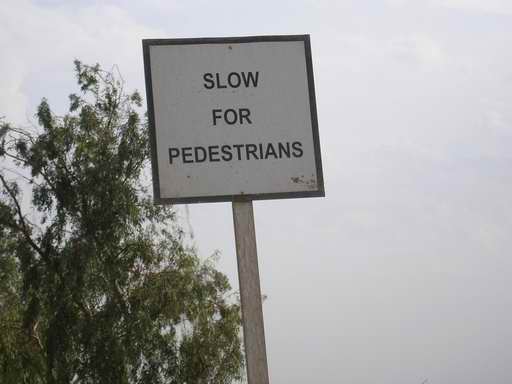When I first got here, we (the Plans Flight) had just acquired a Nissan 4-door pickup. It was brand new, and suffered from one of those little imperfections we've come to associate with vehicles sold to the government in mass quantities. The front seat had plenty of room; the back seat was designed to seat three six-year-olds.
But it was handy to have, so I'm not complaining. At least we had a vehicle. Many Air Force don't have them and for the Army, vehicles seem to be a luxury they only dream about.
Most of the vehicles are not only the same make and model, but also the same color. This can make finding your car after chow challenging, particularly if it's dinner, because darkness falls by 1730 here, and it is black. We have two methods for finding our vehicle after chow. One: we park close enough to the front door that we can see the truck with our distinctive dirt pattern on it when we emerge. Two: we take Sarge along. Sarge is our Lojack. I don't know how he does it. He seems to have a built-in homing device for the pickup.
We decorate the vehicles, of course, to make them more distinctive. Our Nissan had a huge ice scraper across the back window, for example. Jeff bought that at the PX here for the irony value. I didn't have such a heavy duty ice scraper when I lived in Colorado. Why they think someone here might need one escapes me.
A few weeks later, one of the Help Desk airmen borrowed our Nissan and brought it back with a huge dent in the right rear fender. It appears that a Hummer tried to nudge her on the main drag (driven by an Army major, no less--"I didn't see you!"). After that, our vehicle was easier to locate.
All vehicles here take a beating. It goes without saying. Vehicles owned by the government tend to take a beating anyway, but here, we rarely have the luxury of properly poured driveways. With few exceptions, "driveways" here are whereever you make them. You just drive over the curb. (Also, speed bumps--when the Army sees a need--are usually tank treads scattered over the road. Quite effective, I might add.)
Plus there's that sweet temptation of gravel surfing just everywhere. That can't be good for the vehicles.
Speed limits were quite interesting when I first got here, too. Our Nissan only had kilometers on the speedometer. This was handy for the signs around post that gave the speed limit in KPH, but less convenient for the others that gave good-ol'-American MPH. The signs are homemade, I might add. And sometimes, you'd get lucky and these would spring up:

They were sporadic, though. I even saw one once that read "30 KMPH" (30,000 MPH?). By the time I'd returned to the spot with my camera, though, someone had replaced it with the more appropriate but far less amusing MPH/KPH split.
Most of the speed limits are well below what might seem appropriate in the situation. The reason for this is our favorite four-letter word: Army.
First, it's mostly soldiers driving military vehicles around. Hummers are fairly wide vehicles and are designed to go just about anywhere. Apparently, they're difficult to keep on the road at any speed over 25mph.
Second, hordes of soldiers are afoot. This in itself wouldn't seem to be much of a problem, since we have sidewalks that are understood to be off-limits to wheeled vehicles. However, soldiers in a combat zone become very fatalistic in their approach to everything, including crossing roads. They'll just start wandering off in front of you. They don't even look.
So...instead of impressing upon the soldiers that they should be aware that, even though they're being shot at, they can still die if struck by a movin vehicle, too, the Army had a better plan: slow down the traffic. To a crawl. On the main drag (Pennsylvania Avenue), the speed limit is 15 mph--for almost a mile. They've erected this sign:

We've considered the merits of going out under cover of darkness and painting over the "for" portion with something more consistent with reality (like "witted"), but we fancy ourselves above such vandalism.
d

